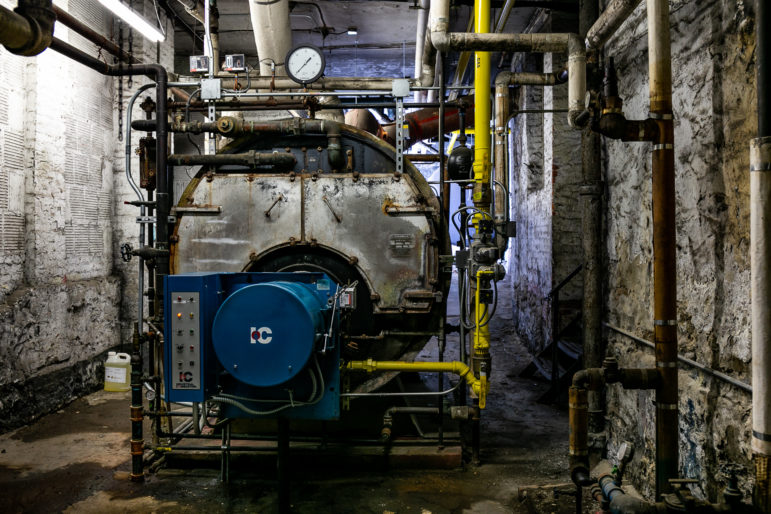
Adi Talwar
New boilers, and new ways of controlling boiler performance and ensuring that heat is delivered efficiently to buildings, are likely to be on the to-do list for many property owners facing the new requirements of Local Law 97.
Amid praise and pushback, the Climate Mobilization Act passed into New York City law last April.
Lauded as the largest emissions reduction policy in the history of any city, the legislative package contains six bills, all of which aim to reduce greenhouse gas emissions in conjunction with the city’s effort to achieve a 40 percent reduction in carbon pollution by 2030 and 80 percent by 2050.
Of the bills included in the package, Local Law 97 stands at the forefront and has received the most buzz as a result.
According to the Inventory of New York City Greenhouse Gas Emissions, a 2017 report published by the Mayor’s Office of Sustainability, 50,000 buildings are responsible for producing 30 percent of all the city’s carbon emissions.
For this reason, Local Law 97 requires all buildings 25,000 square feet or larger to meet new standards for reducing their emissions beginning in 2024. Some examples of conservation features include new windows, efficient heating systems and better insulation.
Exempt from this law are buildings with one or more rent-regulated units, other types of affordable housing and worship spaces. Because hospitals have unique energy demands, their building type was broken into its own category within the law.
Now, nearly six months since the legislation’s induction, stakeholders in big real estate, landlords and environmental advocates remain unsure how long it will take for take for advisory committees to convene, conduct comprehensive research and release recommendations on how to slash carbon emissions by 40 percent before 2030.
Office close to launch
Local Law 97 established the Office of Building Energy and Emissions Performance (OBEEP) within the Department of Buildings (DOB), which is responsible for overseeing the implementation of this legislation. However, OBEEP is not yet up and running.
“[We] will have this office operational by mid-November,” says DOB, noting the 180 day period between Local Law 97 being enacted and it going into effect.
According to the DOB press office, they are currently hiring staff for the new OBEEP.
“The Climate Mobilization did not officially become law until the middle of May, and an office tasked with enforcing the largest carbon emissions reduction can’t be created overnight,” Councilmember Costa Constantinides, Chair of the Environmental Committee and sponsor of the Climate Mobilization Act says in a statement provided to City Limits.
Constantinides says OBEEP will work with landlords, owners and property managers to determine how to best reduce a building’s emissions.
“Skilled experts working in the office will assess a structure’s current emission levels, what systems the landlord currently has in place and work on options to get the property to its required carbon number,” Constanitides says.
“They’ll be able to determine what mix of retrofits, renewable energy and other energy efficiency measures will be best for that particular building.”
A waiting game
Frank Ricci, director of government affairs at the Rent Stabilization Association, explained that many building owners do not know what to do while they wait for OBEEP to get off the ground.
He estimates that these recommendations from the city will likely come out in 2022 or 2024, which raises questions on whether owners will be able to make their retrofits on schedule to reduce emission levels according to the legislation’s benchmarks.
2024 is the first compliance period for buildings to meet reductions set under Local Law 97.
In the meantime, there are some services to help with energy efficiency improvements and reduce operating costs down the road, such as the NYC Retrofit Accelerator, renewable energy certificates and hardship waivers, to name a few.
Until then, it is largely a waiting game in terms of fleshing out larger scale retrofits.
“Most owners aren’t going to do anything until they have some kind of concrete guidance from DOB,” Ricci says. “They don’t want to risk putting money into something that’s not going to be acceptable [in the long-term].”
This is due to the expensive nature of some upgrades. Projected cumulative costs for building owners to make the necessary upgrades may exceed $4 billion, according to Mark Chambers, director of the Mayor’s Office of Sustainability.
“People need time to arrange financing and line up contractors,” Ricci says. “This may take years, especially if it’s a co-op or condominium.”
In order to help offset the cost for building improvements, Local Law 96 of the Climate Mobilization Act established a property assessed clean energy (PACE) program. PACE financing allows owners to take low- or no-interest loans based on the projected savings.
Some owners eye efficiency early
Alan Shamah, a mid-sized landlord who owns 25 buildings between Brooklyn and Upper Manhattan, is already making energy-based updates to his properties. Although he has rent-stabilized units in properties, which exempts him Local Law 97, Shamah still wants to do his part to make energy-efficient changes to his buildings.
To do so, he has installed an ENTECH boiler control system, which analyzes operation to cut energy costs when providing heat and hot water. Shamah also switched all but three of his properties from oil to natural gas, wrapped his heating pipes and added adjustable air valves to radiators through an incentive-based program with Con Edison.
“If I can be using less energy, why wouldn’t I want to?” Shamah says.
But opponents of Local Law 97 worry not all exempt landlords will act in this way.
Because buildings exempted from the carbon emission cap have no legal obligation to contribute to reduction efforts, opponents say those individuals will not make any energy-efficient changes—leaving them to shoulder what they believe to be an unfair burden.
“The owners of 30 percent of the buildings cannot solve a problem caused by 100 percent,” Stuart Saft, an attorney with New York-based law firm Holland & Knight and the president of the Council of New York Cooperatives & Condominiums (CNYC) says. “Everyone has to be involved in solving the problem of climate change.”
Margaret Perkins, a member of 350NYC who sits on the organization’s Steering Committee and was active in grassroots advocacy for the Climate Mobilization Act, is working to put pressure on implementation of Local Law 97.
“They’ve definitely got to get up and moving,” she says.
After attending two panels at Climate Week that discussed Local Law 97 and carbon reduction efforts, Perkins is optimistic that not all commercial real estate owners will drag their feet when it comes to complying.
“There are some bad players: real-estate owners that don’t act in good faith,” Perkins says. “But there are goods ones who have [established] programs to get their emissions down and are putting money into it because they see they’re going to save.”
“It’s just [a matter of] how committed they are.”
Growing acceptance
Despite initial pushback, Constantinides says that practically everyone except the deep-pocketed few have embraced the Climate Mobilization Act, mentioning the positive response he received from labor unions like DC37, the Queens Chamber of Commerce and other cities and states’ governmental agencies.
“The Climate Mobilization Act was written in a way that’s flexible as to how [property owners] make reductions, promotes clean energy in buildings, establishes a low-cost financing system and is adaptive if the targets can’t be made,” Constantinides says.
And, in some cases, organizations have changed their tune when it comes to the Climate Mobilization Act.
The Real Estate Board of New York (REBNY) was outspoken in the lead up to the vote and its president John Whelan roundly critiqued the legislation in April, arguing that the City Council was taking New York City down the wrong road toward an unachievable goal.
However, Whelan recently penned a column for Real Estate Weekly, giving props to various REBNY members leading the way on energy reductions.
“The reality is that across our industry, New Yorkers can see what is possible—and the importance of never staying complacent or satisfied,” Whelan says. “We must continue to push the boundaries and support new technologies that will help us reduce our carbon footprint.”
To trade or not to trade
Local Law 97 commits the city to study and report by 2021 whether a cap-and-trade system will work in New York City.
Constantidies says the working group convened by the Urban Green Council, comprised of building exerts, environmentalists, advocates and lawmakers (himself included), will determine if such a trading scheme is feasible here.
“We want to strike the balance in which our emissions actually go down,” Constantidies says. “But we don’t want landlords to lower emissions on Fifth Avenue buildings so they don’t have to do anything for their properties in Harlem.”
In a statement provided to City Limits, John Mandyck, CEO of Urban Green Council, explained that there is no question that carbon caps in New York City are tough but explained that emerging solutions to offset costs are emerging.
“We’re pursuing building carbon or efficiency trading as an effective, lower-cost solution to securing the carbon reduction we need,” Mandyck says, referring to the five-city initiative to study trading. “It’s a breakthrough city policy tool not only for New York but urban centers across the globe.”
While OBEEP is in flux, many forward thinking organizations are providing their own resources for building owners to tackle carbon reduction and better understand the contents of the bill.
“One of the things that people are really looking forward to is if there are going to be any new technologies that get hammered out as time goes on that will give owners a way to comply,” Ricci says.
The Building Energy Exchange designed the Climate Mobilization Act series to demystify the legislation’s components and connect the community with relevant solutions. Its upcoming program will focus on Local Law 97 retrofit measures. Sentient Buildings released five steps of suggestions to help owners comply, starting with an energy efficiency audit. And Bright Power works with owners to recommend improvements that will result in not only legal compliance but also increased efficiency and savings.
“For most [buildings], we can turnkey design-build those improvements, expediting the time it takes for our clients to reap the benefits of lower energy consumption and operations costs,” says Bright Power president and founder Jeffrey Perlman.
Other laws in the Climate Mobilization Act focus on green roofs and solar photovoltaic electricity generators, building energy efficiency grades and wind energy generation.










0 thoughts on “Big Decisions Loom on How NYC Will Implement Historic Carbon-Reduction Law”
Pingback: Health & Wellness: Shamco Management does their part for a Cleaner Environment – Shamco Property Management